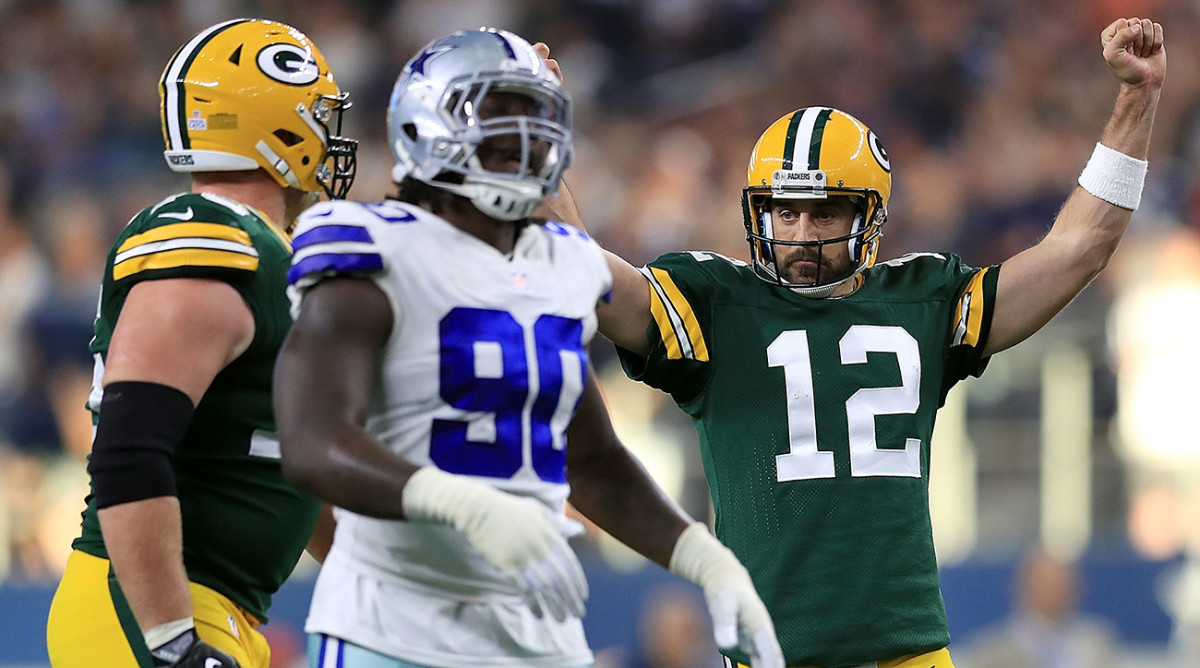Packers-Cowboys: The Game of the Year So Far

Even if you took away Aaron Rodgers’ game-winning touchdown drive, Packers-Cowboys was still the best game this season. By far, in fact. Two quality, marquee teams playing their brands of football at the highest of levels. They gave us 12 rounds of back and forth blows, with a knockout punch by the game’s most talented quarterback just before the final bell. We’d gotten a similar show from these teams in last season’s Divisional Round, and it almost feels greedy to even wish for a third one this January.
The first half was the Dak Prescott Show—again. The question entering this season was: How would Prescott look when his near-perfect circumstances (great OL, dominant ground game, diverse array of receivers) inevitably regressed to more normal levels? Perfect circumstances never last in pro sports, and indeed this season has presented Prescott with adversity for the first time in his pro career. With the Cowboys’ O-line struggling (by its skyscraping standards), Ezekiel Elliott following suit and Dez Bryant looking like a shell of himself in the first quarter of the season, Prescott has had to become more of a playmaker.
Against Green Bay, Prescott made several plays with his legs—his mobility shines most when he makes high-velocity throws on the move outside. Prescott gave Dallas’s passing game some lifelines, and eventually it started winning in its trademark ways. Bryant, not shadowed by a premium corner for the first time all season, got open on in-breaking routes. Cole Beasley scored twice with his patented shiftiness—once on an almost indefensible quick-out vs. corner Davon House and again on a slot quick-in versus corner Quinten Rollins who, fearing the quick-out, surrendered too much cushion. In the second half, Jason Witten caught a deluge of the short, zone-killing Y-stick routes that have undergirded his Hall of Fame career.

Throughout all this, the Cowboys stuck to their ground game, which at best was a grind. The Packers, typically a light dime defense, played more in their 5-2 front, just as they did in Week 4 against the run-oriented Bears. That front, led inside by a healthy-again Mike Daniels, and on the edges by Clay Matthews and Nick Perry, got the better of Dallas’s dominant O-line for three quarters. But by the fourth quarter, with 21 running plays in the books, the tables turned. The Cowboys O-line started grading the road and Elliott came to life. He ran seven times for 35 yards on an 8-minute, 43-second touchdown drive that put Dallas ahead late in the fourth. Fittingly, that drive ended with Prescott’s 11-yard read-option TD—another Cowboys staple, as Prescott’s legs are always a bigger factor in the red zone.
FOX showed Jerry Jones and his sons up in their booth following that touchdown. The men exhibited no jubilation, only worry. Aaron Rodgers still had 1:13 to work with.
What followed was a sequence that should run on a loop in a glass display at the Lambeau Field Atrium. No drive better illustrates Rodgers and Mike McCarthy than that last one Sunday at Dallas.
It’d been a solid, balanced performance by Green Bay’s offense up to that point. Fifth-round rookie running back Aaron Jones had 108 rushing yards (he finished the game with 125), running with excellent tempo and balance. Rodgers, overcoming an O-line that remains makeshift on the left side, and dealing with frustration towards his receivers, had avoided mistakes and conjured the occasional big play. The Packers had kept themselves in it.
The Heroics of Aaron Rodgers and Earl Thomas, Big Ben Bombs, Odell Beckham Goes Down Again
Now they had a chance to win. And to do so, they turned to the first page of every chapter in the McCarthy/Rodgers playbook. It started with a back-shoulder throw to Davante Adams. (Usual suspect Jordy Nelson was out with an undisclosed injury.) Adams snagged the perfect strike versus sturdy rookie corner Jourdan Lewis. 14 yards.
Then Rodgers flung a ball into the flat to tight end Martellus Bennett. It came on a three-receiver side, with the other receivers’ routes offering natural rubs on defenders, creating space for Bennett’s run-after-catch. Another 14 yards.
Then, a slant-flat route combination—Green Bay’s top concept. It fell incomplete, but slant patterns had helped put the Packers in this position to begin with (Rodgers had attacked Cowboys corner Anthony Brown with them throughout the game).
After a 15-yard shotgun run by Aaron Jones against a Cowboys diamond front (five players up on the line, zero linebackers, a great front to run against), the Packers hit a lull and soon faced third-and-8. The Cowboys, as they’d done much of the afternoon and in both meetings last season, played dime and rushed three. Either linebacker Justin Durant or Jaylon Smith was likely supposed to spy Rodgers, but both men reacted to the running back Jones’s late release. Rodgers noticed this and scrambled for 18 yards.
Then, back to work on the Adams-Lewis matchup. Rodgers attacked it with a fade ball that was too low and flat, allowing Lewis to make the deflection. On the next snap, Rodgers threw a similar ball, only the call was back-shoulder. Adams was ready, and it reached his hands almost before Lewis could even know it was in the air. Good defense. Better offense. Great football.
• Question or comment? Email us at talkback@themmqb.com.
